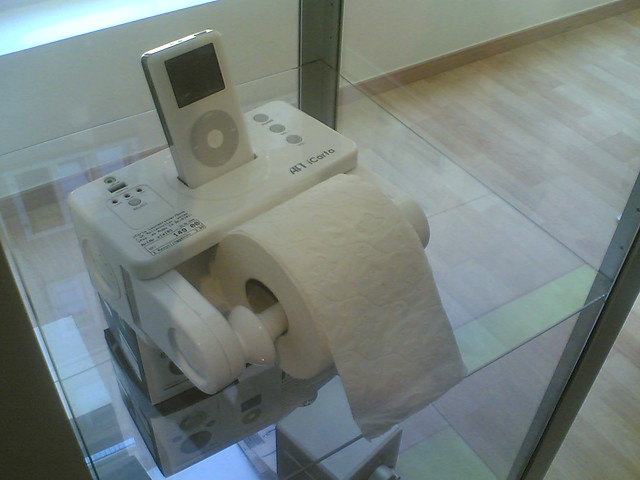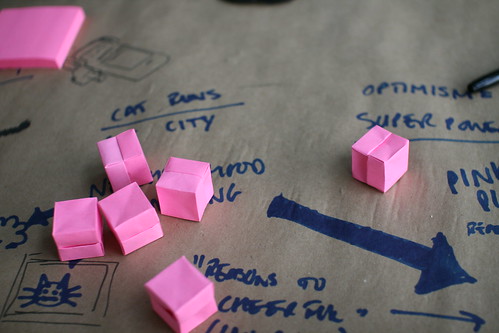Recently, a journalist asked me what are the console games that I found interesting lately. I froze for a while, told him about 3 games: Superbrothers: Sword & Sworcery EP, Minecraft and Dwarf Fortress... and realize none of them were available on consoles...
Few notes about these 3 video-games that caught my attention in the last few months. Each of them made me wonder about the possibility to go beyond standard console games through various aesthetics and forms of interactions.
Superbrothers: Sword & Sworcery EP (S:S&S)
S:S&S EP is the video game that reconciled me with storytelling, a feature that I largely ignored in the last few years. Described as a "21st century interpretation of the archetypical old school videogame adventure, designed exclusively for Apple's touchtronic machinery", it's an intriguing mix of "laid-back exploration, careful investigation & mysterious musical problem-solving occasionally punctuated by hard-hitting combat encounters". Exactly what I needed after a tough series of weeks organizing conferences.

As discussed by game’s creator/artist/animator Craig D. Adams in this interview, the game was inspired by Shigeru Miyamoto’s design sense with the original Super Mario Bros, Jordan Mechner’s original Prince of Persia and Eric Chahi’s Another World because all off these "have a cinema-influenced style, expressive human movement and a more grounded narrative concept". This combination of players' interactions with "sound, music & audiovisual style" underpinned by a basic narrative and very low-key dialogues made me tick. More specifically, I am impressed by the rhythm of the game, which is sometimes super slow/contemplative and sometimes very quick/nervous in combat.

Also, one of the curious feature of the game is the integration of social software in the game. You input your twitter login/password and you can broadcast dialog, hints, descriptions from the game to your twitter channel. It's pretty basic right now (lots of people tweet the same things) but I guess this is the beginning of something and there could be an interesting potential in also using content coming from tweets tagged with the #sworcery hashtag.
Minecraft (Markus Persson)
Minecraft has a very clear value proposition (I find this term funny), it's a (sandbox) game that engage users in placing blocks to build anything they can imagine. As described in the Wikipedia:
"The core gameplay revolves around construction. The game world is essentially made up of cubical blocks arranged in a fixed grid pattern, that represent different materials, such as, dirt, stone, various ores, water, tree trunks, etc. While the players can move freely across the world, objects and items can only be placed at fixed locations relative to the grid. The player can gather these material "blocks" and place them elsewhere, thus potentially creating various constructions."

The game was kind of a puzzle for the video game industry because of various characteristics. It doesn't follow the AAA marketing logic, graphics and are super basic, it's a simple download (no app store), you buy it with PayPal, no marketing/publicity, no publisher. But this is not what I found interesting.
Chris DeLeon has a good perspective on what makes Minecraft an important platform. He describes that it's a game about discovery:
"Discovering what’s beyond the horizon, discovering new cave systems, discovering incredible projects others have done, discovering new features snuck into updates, discovering new like-minded people, discovering architecture / electronics / sculpture / texturing / landscaping / action / photography / decorating / music / trading / storytelling / adventure / modding, and discovering that we all love to make things, provided that we have an accessible and cost-effective way to do so."
Dwarf fortress (Bay 12 Games)
Even geekier than Minecraft, Dwarf Fortress is a combination of a roguelike and city-building games in which the user interface has been limited to text. A sandboy-style simulation platform, it's a game that allows the player to build and organize a city of dwarves.

What I love in Dwarf Fortress is simply the spatial environment, its representation, how you interact with it as a player and how it's generated by the computer. As written in the Wikipedia:
"Prior to play, a world must be generated using the software or downloaded from the Internet. Each constructed world is unique; events that take place during play will affect subsequent games in the same world. World creation in Dwarf Fortress is elaborate: terrain is generated using fractals, erosion is simulated, then wildlife, towns, and other sites are placed. A specific history is attached to each site; references to these events can be found during gameplay (in artwork and conversations with non player characters (NPCs)), and development's current focus (as of April 2008) is to make world generation wars determine in-game territory distribution and NPC background stories."


Readers interested in this game can have a look at this masters thesis by Joshua Diaz about how the "space, code, and player choice (...) not only encouraged players to view the game as a world full of stories, but also gave players tools to craft their own kinds of tellable moments through the game".
Why do I blog this? Writing some quick notes about these games as a pointer in further discussion about the evolution of video games, the importance of looking at the fringes and the spatial component in virtual environments.




 Anyone interested in robots and networked objects in multi-functions artifacts may be intrigued by this gorgeous AM/FM restroom radio with telephone that I ran across at the flea market the other day.
Anyone interested in robots and networked objects in multi-functions artifacts may be intrigued by this gorgeous AM/FM restroom radio with telephone that I ran across at the flea market the other day.






 The ubiquitous presence of cell phone towers in urban and rural landscapes have led to protestation against their visual presence (the ugly mast/transmitter aesthetics) and their electromagnetic waves (which are invisible). A side-effect of people's "need" for uninterrupted connectivity, the design and building of phone towers is now influenced by various strategies. One of them consist in the use of camouflage techniques... and obviously the "natural" metaphor plays an important role here, as attested by these examples encountered in Lipari, Sicily last week.
The ubiquitous presence of cell phone towers in urban and rural landscapes have led to protestation against their visual presence (the ugly mast/transmitter aesthetics) and their electromagnetic waves (which are invisible). A side-effect of people's "need" for uninterrupted connectivity, the design and building of phone towers is now influenced by various strategies. One of them consist in the use of camouflage techniques... and obviously the "natural" metaphor plays an important role here, as attested by these examples encountered in Lipari, Sicily last week.



 (Networked objects being designed at the
(Networked objects being designed at the  (Potential candidates as blank objects meant to receive memories?)
(Potential candidates as blank objects meant to receive memories?)






 "Take me, sit on me, love me" :)
"Take me, sit on me, love me" :)
 There's this part of the airport in Geneva that has this fascinating setting. Several remarks:
There's this part of the airport in Geneva that has this fascinating setting. Several remarks:



 (A robot tinkerer's desk at the design museum in Zürich)
(A robot tinkerer's desk at the design museum in Zürich)




 (A courier in Seoul who make gestures when using his mobile phone)
(A courier in Seoul who make gestures when using his mobile phone) Another interesting keyboard adaptation that I ran across in one my course. This designer is working on a large graphic and needs to drag and drop lots of visual primitives here and there with Illustrator. She found it more convenient to use this quick and dirty solution by using tiny stickers with a visual representation of the graphical elements on each keys.
Another interesting keyboard adaptation that I ran across in one my course. This designer is working on a large graphic and needs to drag and drop lots of visual primitives here and there with Illustrator. She found it more convenient to use this quick and dirty solution by using tiny stickers with a visual representation of the graphical elements on each keys.